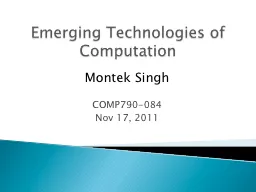

Montek Singh COMP790084 Nov 17 2011 Two different technologies Previous Class DNA as biochemical computer DNA molecules encode data enzymes probes etc manipulate data TODAY ID: 513460
Download Presentation The PPT/PDF document "Emerging Technologies of Computation" is the property of its rightful owner. Permission is granted to download and print the materials on this web site for personal, non-commercial use only, and to display it on your personal computer provided you do not modify the materials and that you retain all copyright notices contained in the materials. By downloading content from our website, you accept the terms of this agreement.
Slide1
Emerging Technologies of Computation
Montek
Singh
COMP790-084
Nov
17,
2011Slide2
Two different technologies
Previous Class:
DNA as biochemical computerDNA molecules encode dataenzymes, probes etc. manipulate dataTODAY: DNA used to assemble electronic computerDNA molecules used as scaffoldingnanoscale electronic components piggybackDNA assembles the computer
Today: Computing using DNASlide3
Pioneering work by Chris Dwyer et al.PhD at UNC; now faculty at Duke
Key Idea:
Exploit constraints on DNA bonding to design DNA sequences that will only come together in predictable waysPiggy back components of interest on top of DNA: transistors, wires, etc.Terminology:functionalization: attaching DNA strand to a component of interestBasics of DNA Self-AssemblySlide4
3 distinct DNA-functionalized objects assemble into a triad if sequences are carefully chosen
Forming a triadSlide5
Extend idea to 2D grid
Protein attached to form the
pattern “CAD”Forming a gridSlide6
Three rods, anchored to a solidassembly in several steps
Basic
cuilding block: Triangular structureSlide7
Extend the triangle into this structure
Cubic unit cellSlide8
Transistors“ring-gated field-effect transistor”
RG-FET
Electronic componentsSlide9
Nanowires (gold)
Electronic componentsSlide10
2-input NAND
Let’s make a gate!Slide11
Embed in a DNA cube of insulating unit cellsgray-shaded ones are gates/wires
Give it some structural supportSlide12
Simple method:
How many distinct DNA strands?
More economical method:
build one face at a time: only 15 unique sequences!Slide13
Challenge:orientation is unpredictableIdea:
use self-discovery
Power and I/OSlide14
Idea:use self-discovery
take cue from rectifier circuits
Power and I/OSlide15
Idea: use self-discovery
Power and I/OSlide16
Use hierarchical assembly
What about larger structures?Slide17
Use hierarchical assembly
What about larger structures?Slide18
Use hierarchical assembly
What about larger structures?Slide19
Design and verification remain challengesstructures only with a handful of transistors
yield only about 50-70%
but… materials are cheap though$40 for the “CAD” experimentaddressabilityunique and independent functionalizationarchitectures, interconnectioninherent element of randomnessI/O especially difficultCAD tool supporttiming unpredictable
Challenges in self-assemblySlide20
Really tiny!unobtainable in silicon… except electron beam, extreme UV or X-ray lithography
Potentially much larger scale
can produce in seconds what a commercial foundry does in days or weeksPotential benefits of self-assemblySlide21
Design Automation:Pistol et al., DAC
2006
Dwyer, ICCAD 2005Routing:Liu et al., JETC 2010Patwardhan et al, JETC 2006Nanoscale sensors:Pistol et al., ASPLOS
2009,
Micro
2010
Nanoscale
optical computing:
Pistol et al.,
Micro
2008
Further Reading